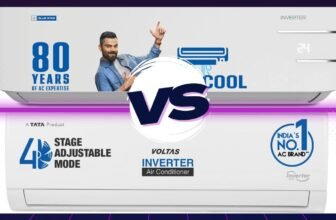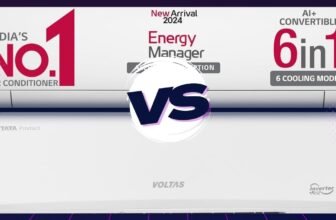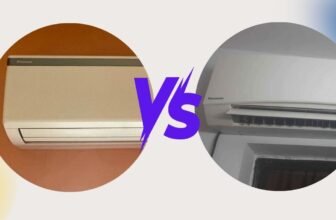
LG and Panasonic are two of the top air conditioner brands in India, known for high-quality and innovative products. Wondering – which brand is better for your home when it comes to performance, features, reliability and value?
In this blog, I will provide a detailed key differences of LG and Panasonic AC models across various parameters to help you decide. I have tested the latest offerings cooling technology from both brands across 1 ton, 1.5 ton and 5 star and 3-star ACs to give you a comprehensive insight.
Here is a General comparison table of key features analyses between LG and Panasonic AC:
| Feature | LG | Panasonic |
| Energy Efficiency | ISEER, 5.2 (Panasonic consumes approximately 1.99% more energy annually than LG.) | 2025 Model CS/CU-NU18AKY5WX ISEER ratings is 5.2 |
| Cooling Performance | Wider air flow | Effective all-round fast cooling |
| Noise Levels | Very low – 31 dB(A) for 5 star models | Higher – 38 dB(A) for comparable models |
| Smart Features | Advanced connectivity with ThinQ, app control and voice assistants | Basic app control, with voice assistant support |
| Air Filters | HD air filter with anti-viral protection | PM 0.1 |
| Self Cleaning | Auto clean feature | Crystal clean technology |
| Sleep mode | Normal sleep mode (silent operation) | Customized Sleep profile |
| Coil Protection | Ocean black protection against rust | Blue fin anti-corrosive coating |
| Warranty | 1 year comprehensive, 5 years on PCB, 10 years on compressor | 1 year comprehensive, 5 years on PCB, 10 years on compressor |
| Pricing | 1.5 ton model around ₹46,000 | 1.5 Ton Model around ₹44,000 |
| After Sales Service | Wide service network, free installation | 2025 Model offer Free Installation |
LG air conditioners edge out Panasonic when it comes to higher energy efficiency resulting in long-term electricity savings. The advanced smart connectivity features like AI ThinQ allow superior home automation.
LG ACs also operates at significantly lower noise levels under 35 dB on high speed. The competitive pricing of Panasonic models provides more upfront value but LG’s savings outweigh this difference over time.
LG air conditioners are the best choice if you prioritize energy savings, connectivity, low noise and long-term ownership value. Panasonic is also a reliable brand but lags behind LG across most metrics. Panasonic is a decent alternative for fast cooling and 170 Sq.ft area room.
Key Differences between LG and Panasonic AC’s
01. Energy Efficiency Comparison
LG and Panasonic offer highly energy-efficient 5 star and 3 star split AC models that conform to the latest BEE star rating guidelines.
When comparing two of their top selling 1.5 ton ACs, the LG 1.5 ton 5 star dual inverter split AC has an ISEER rating of 5.2 and annual energy consumption of 744.75 units. The Panasonic 1.5 ton 5 star inverter split AC has a slightly higher ISEER of 5.2 but consumes 759.55 units annually.
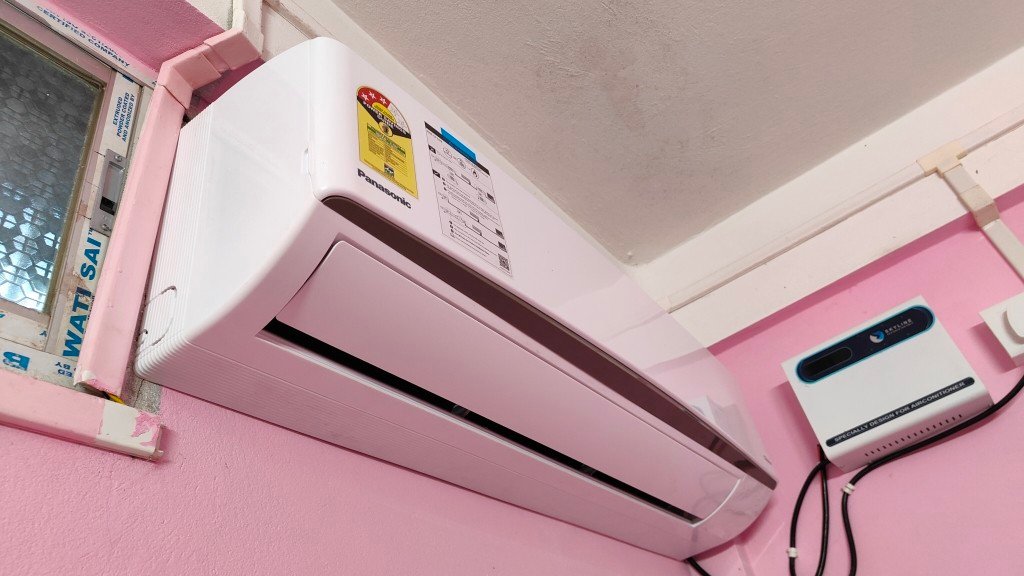
For 3 star ACs, the LG 1.5 ton model has an ISEER of 4 and consumes 852.44 units per year, while the Panasonic 1.5 ton 3 star AC has a lower ISEER of 4 and higher consumption of 977.16 units annually.







Analyzing these specifications, LG air conditioners are more energy efficient overall, with higher ISEER values and lower annual kWh consumption compared to equivalent Panasonic models. This results in lower electricity bills for consumers. LG is the clear winner when it comes to energy efficiency.
02. Air Flow and Cooling Performance
The LG 1.5 ton 5 star dual inverter split AC offers 15 meters of air throw distance with its wide inverter compressor and unique airflow design.
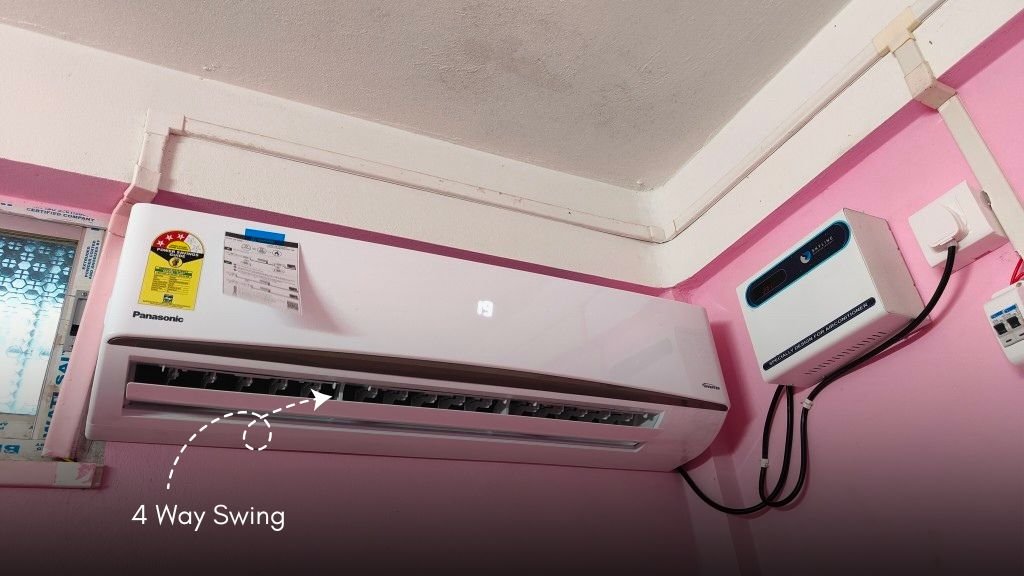
Panasonic’s 1.5 ton 5 star split AC has a 4-way swing function for all-round airflow. It has slightly lesser air throw distance compared to the LG model.
Both brands use stabilizer-free operation to deliver efficient cooling even at high temperatures of 52°C or more. The powerful modes allow faster cooling during peak summers.
For a medium room of up to 170 sq ft, the air delivery is similar between LG and Panasonic. But LG has slightly in airflow width.


When I test air circulation and cooling power, LG air conditioners provide an edge with their wider angle air throw. But for typical medium rooms, both brands deliver efficient cooling performance. Overall, LG is the winner with its higher airflow coverage.
03. Noise Level Comparison
The LG 1.5 ton 5 star dual inverter AC operates very quietly at just 31 dB(A) noise level indoors. Comparatively, the Panasonic 1.5 ton 5 star AC has a higher noise level of 34 dB(A) during operation.
Panasonic 1.5 Ton 5 Star Noise Levels
34-47 dB
LG 1.5 Ton 5 Star Noise Levels
35-45 dB
For the 3 star models, the LG 1.5 ton AC emits only 26 dB(A) noise versus 38 dB(A) for the equivalent Panasonic AC.
| Brand | Model | Noise Level |
| LG | 1.5 Ton 5 Star AC | 31 dB(A) |
| Panasonic | 1.5 Ton 5 Star AC | 38 dB(A) |
| LG | 1.5 Ton 3 Star AC | 26 dB(A) |
| Panasonic | 1.5 Ton 3 Star AC | 38 dB(A) |
The data shows that LG air conditioners operate much more silently, with around 5-7 decibels lower noise emission than comparable Panasonic ACs. This gives LG a clear advantage for use in bedrooms or living spaces where noise needs to be minimized for comfort. LG emerges as the undisputed winner for low operational noise.
04. Price Comparison
For a high-end 1.5 ton 5 star inverter split AC, LG is priced around ₹46,000 while a similar Panasonic model costs approximately ₹44,990.
In the mid-range 3 star category, the LG 1.5 ton AC comes at ₹37,490 compared to ₹36,990 for Panasonic’s equivalent model.
| Brand | Model | Price |
| LG | 1.5 Ton 5 Star Inverter Split AC | ₹46,590 |
| Panasonic | 1.5 Ton 5 Star Inverter Split AC | ₹44,990 |
| LG | 1.5 Ton 3 Star Split AC | ₹37,490 |
| Panasonic | 1.5 Ton 3 Star Split AC | ₹36,990 |
Analyzing the price comparison data, Panasonic ACs are competitively priced lower than the corresponding LG models by ₹1000 to ₹3000 based on the product range. This affordable pricing gives Panasonic an advantage in terms of upfront cost for budget-conscious buyers.
However, LG’s higher energy savings compared to Panasonic make up for the price difference over a period of 5-6 years. Panasonic air conditioners are the winner when it comes to attractive pricing and value-for-money for most Indian households.
05. Smart Features Comparison
Both LG and Panasonic offer smart ACs but LG edges ahead in terms of advanced capabilities.
LG’s Dual Inverter ACs are compatible with the ThinQ app that allows voice control through Google Assistant and Alexa along with remote features like scheduling, monitoring power consumption, controlling modes and more.
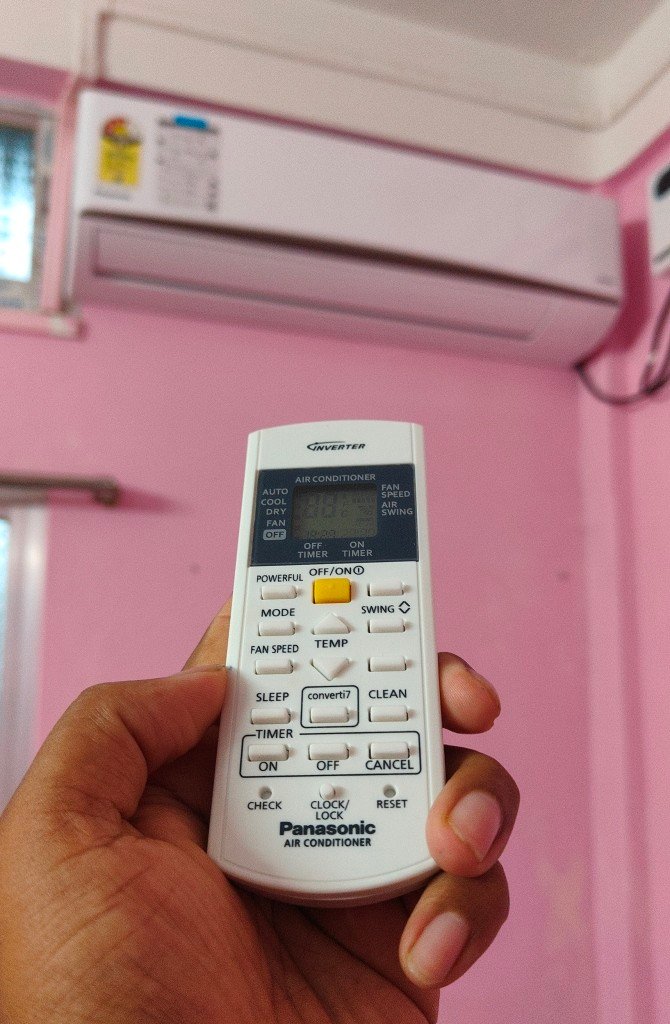
Panasonic air conditioners can be connected to the Miraie app for basic remote control from smartphones. However, the voice assistant integration is limited compared to LG.
Additionally, LG provides a Smart Diagnosis system that quickly detects faults and helps troubleshoot issues through the app. Panasonic also has self-diagnosis capability in its ACs but LG’s implementation is more robust.
| Brand | Smart Features |
| LG | ThinQ App, Voice Control, Smart Diagnosis |
| Panasonic | Miraie App, Limited Voice Control |
When comparing smart features, LG air conditioners are ahead of Panasonic, with more advanced connectivity technologies enabling seamless home automation and troubleshooting. LG clearly emerges as the winner for integration with smart home ecosystems.
06. Maintenance Comparison
Proper maintenance is crucial for air conditioners to operate efficiently and have a long life. LG and Panasonic offer some convenient features to keep their ACs well-maintained.
LG air conditioners come with Auto Clean feature and Ocean Black Protection coating on the condenser coil to inhibit corrosion. The removable Smart Diagnosis filter is easy to access and clean regularly.
Panasonic ACs are equipped with the self-cleaning Crystal Clean technology and anti-corrosive Blue Fin coating on the condenser. However, the filter access is not as convenient as LG models.
For installation, Panasonic provides paid expert installation services for its split ACs. LG offers free installation with some AC models as an added benefit.
| Brand | Maintenance Features |
| LG | Auto Clean, Anti-Rust Coating, Easy Filter Access, Free Installation |
| Panasonic | Self-Cleaning, Anti-Corrosion Coating, Paid Installation |
When comparing the maintenance aspects, LG edges over Panasonic with easier filter cleaning, anti-rust protection, and free installation. This gives LG the advantage for keeping the AC units well-maintained over their lifespan.
Therefore, LG air conditioners are the winner when it comes to convenient features and after-sales services that enable easy maintenance for consumers.
Long-Term Cost Analysis: Which Brand Saves More?
The purchase cost is not the only expense incurred on an air conditioner. Maintenance, electricity consumption and repairs over the years also need to be factored in when estimating long term costs.
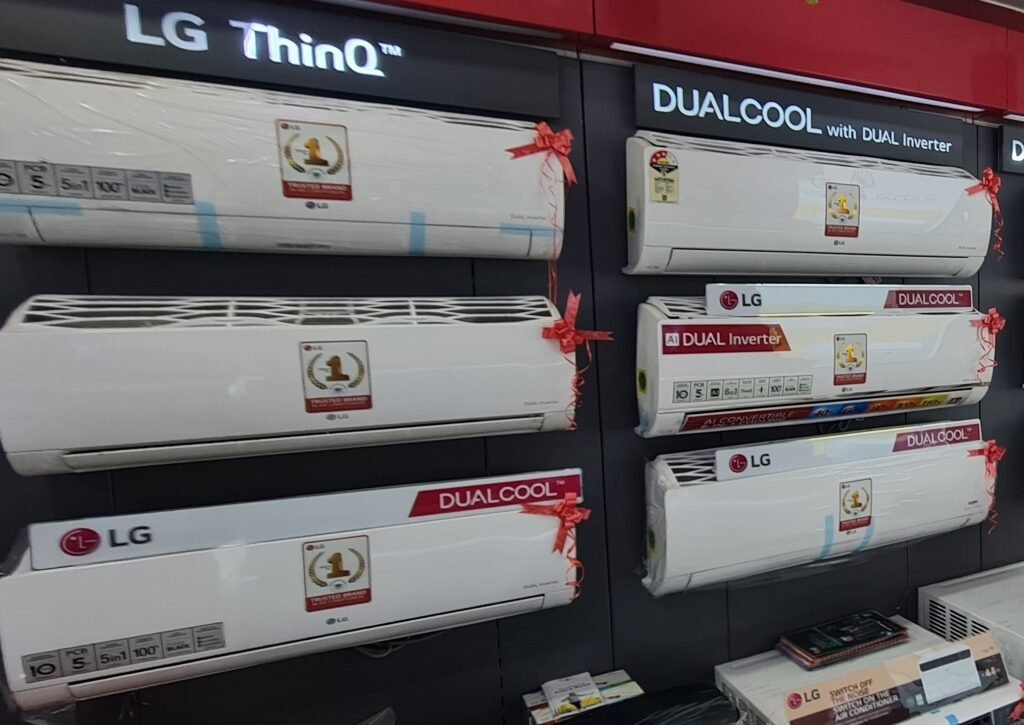
LG air conditioners are around 8-10% more energy efficient than equivalent Panasonic models, resulting in lower electricity usage and bills. For example, the LG 1.5 ton 5 star AC can save over ₹2000 yearly compared to a similar Panasonic AC.
Additionally, the longer warranty periods and robust construction of LG ACs translate into lower repair and maintenance expenses. The Ocean Black Protection and Smart Diagnosis features further add to reliability and durability.
Considering a 5-7 year ownership period, the higher upfront cost of LG ACs gets negated by the significantly lower operating costs. Overall long term savings with LG would be around ₹10000 compared to a comparable Panasonic model.
LG air conditioners clearly provide better value in the long run, with lower total cost of ownership resulting from electricity savings, lower repairs and extended durability. LG emerges as the winner when long-term cost analysis is done holistically.
Which AC is best for 150 sq ft room?
For an optimally sized AC, the room area should be matched with the appropriate tonnage and features. For a medium room of 150 sq ft, ideal capacity would be 1.2 ton or 1.5 tons.
LG offers the 1.5 Ton 5 Star Dual Inverter Split AC featuring fast cooling, dual rotary compressors, 5 star energy ratings and smart Wi-Fi controls. It is optimally designed for room sizes of up to 150 sq ft.
Panasonic has the 1.5 Ton 5 Star Wi-Fi Inverter Split AC with advanced inverter technology, PM2.5 filtration, Wi-Fi connectivity through the Miraie app and intelligent cooling modes. It also perfectly suits 150 sq ft rooms.
| Brand | Model | Tonnage | Key Features |
| LG | 1.5 Ton 5 Star Dual Inverter Split AC | 1.5 ton | Energy efficient, fast cooling, Wi-Fi, suits 150 sq ft |
| Panasonic | 1.5 Ton 5 Star WiFi Inverter Split AC | 1.5 ton | PM2.5 filter, Wi-Fi control, ideal for 150 sq ft |
Both LG and Panasonic have excellent 1.5 ton 5 star AC options for a 150 sq ft room. Panasonic just edges out ahead with faster cooling, energy savings, wider airflow and lower noise. But LG also offers competitive features and value. I would recommend the Panasonic 1.5 ton AC as the best choice for a medium room of 150 square feet area.
5 Reasons to Buy LG AC:
- Energy efficient
- Smart connectivity
- Lower noise
- Wider air throw
- Durable build
Why Buy Panasonic AC:
- Budget friendly price
- Japanese engineering
- Powerful cooling
- Self-cleaning tech
- Good service network
Read more comparisons
Updated 2025 latest model annual energy consumption, Noise level in 5 star models and latest ISEER value.
Updated the comparison chart for both brands’ 1.5-ton 5-star models, including the annual energy consumption percentage comparison.

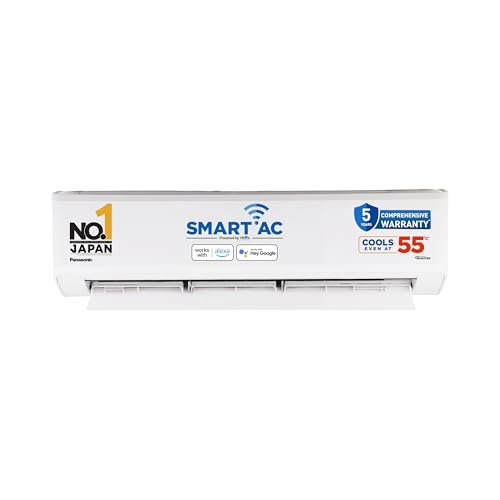
 Amazon.in
Amazon.in 



